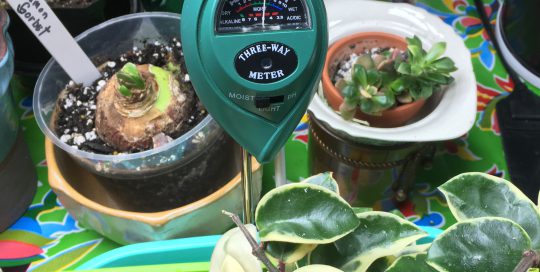The Basics of Propagation
By Dona Bergman
This is an article about the basics of propagation.
Recently, Wonderful Husband and I went on our first vacation ever. When we left southern Indiana, it was early autumn. Before we left, I’d planned on cleaning up the yard, removing the annuals, and taking in the plants I wanted to overwinter. But, that would have to wait until I returned.
Geraniums Near Death from a Hard Freeze
Unfortunately, while we were away, there had been a hard freeze. The tender perennials I’d intended to move indoors were nearly dead. Two potted geraniums had been sheltered under the eaves of the house. I thought perhaps they might be salvageable. As with many of our plants, the geraniums have sentimental value. Wonderful Husband’s Aunt Jane had given the parent plant to us. She passed away about three years ago, but every time I water the geraniums or see their coral pink blooms, I think of her and smile.
Geraniums After Hard Freeze – photo by Dona Bergman
Plant Salvation Started with Major Surgery
Saving these plants was going to require major surgery, but it was worth a try. First, I removed all the damaged leaves which left the stems nearly bare. Only the tops had tiny leaves that appeared to be unharmed.
After scrutinizing the naked geraniums, there was an opportunity to shape the plants for next year – assuming they survived. I also thought I might be able to take some cuttings and use the basics of propagation. I thought if the parent plants didn’t live, I might be able to root the cuttings. That way I could keep Aunt Jane’s gift alive for another growing season (and beyond).
Geraniums Can Take a Licking and Keep on Ticking
Fortunately, geraniums are tough plants with a strong will to live. They can survive winter as a houseplant or a dormant plant stored in a garage or other cool place. The parent plants, sans most of their leaves and stems are now basking in the sunlight in a south-facing window.
The Basics of Propagation
The basics of propagation are not complicated nor expensive. Actually, taking cuttings and rooting them in potting soil or water is easy:
- Using a sharp knife or scissors, trim the stems back to just above a leaf node. The plant should grow one or two new stems from the leaf node. Basically, you’re performing the same technique as “pinching back” the plant to encourage fuller growth, except you’re removing a longer section.

With Sharp Knife, Cut Just Below a Node – photo by Dona Bergman
- You can divide a long stem into several cuttings. Again, use a sharp knife or scissors and cut just below a leaf node; this will (with luck) grow roots. Leave at least one leaf node above the ‘root’ node – it will grow new leaves.

Divide Stem Into Multiple Cuttings – photo by Dona Bergman
- At this point, you can dip the stem in rooting hormone if you wish and then insert the ‘root’ node into potting soil.
- OR – instead of using potting soil, you can simply place the root node in water (again, if you want, dissolve a little rooting hormone in the water). The main thing to remember is which way is up – an upside-down stem will just die.

Place Stem in Water – photo by Dona Bergman
- Place your cuttings in bright, indirect light, don’t let the cuttings dry out (or keep the water above the root node) and hope for the best.
Propagation Can Be Effective for Many Plants
Many plants can be propagated by taking cuttings – houseplants like African violets (Saintpaulia), jade plants (Crasssula ovata), begonias, philodendrons, schefflera and spider plants (Chlorophytum comosum). Cuttings from some shrubs and trees can also work – I’ve had success with roses, button bushes (Cephalanthus occidentalis), pussy willows (Salix discolor), weeping willows(Salix babylonica) and black gum trees (Nyssa sylvatica, also known as the black tupelo tree). In general, for trees and shrubs, select the soft green part, not the woody sections.
Let the Basics of Propagation Work for You
Whether the purpose of propagation is to save an heirloom, share with a friend or grow more cool plants for your own garden, cuttings are an inexpensive and easy technique to use. Checking on the little cuttings and hoping to see roots helps the dreary winter days go by more quickly. If you haven’t already, give this technique a try … the worst that can happen is that it won’t work, right?











